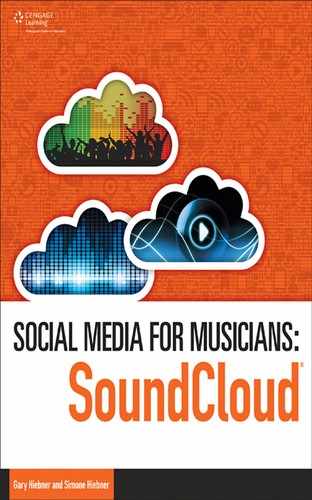3
How to Upload
SO YOU’VE CREATED YOUR SOUNDCLOUD ACCOUNT, and you’re now ready to upload your music and start sharing. Let’s take a look at how this is done. The great thing about SoundCloud is that it can recognize most of the different types of audio formats. For a full lists of the formats that are supported, see the “SoundCloud and Supported Audio Formats” section at the end of this chapter.
At the top menu bar, next to your profile icon, there is an Upload button, as shown in Figure 3.1. Click this to bring up the Upload dialog box. Now you have two choices: Choose a File to Upload or Start New Recording, as shown in Figure 3.2.
Figure 3.1 Upload to SoundCloud.
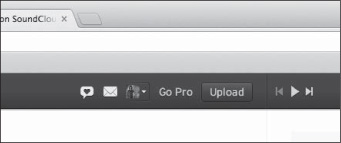
Source: SoundCloud®.
Figure 3.2 The SoundCloud Upload choices.

Source: SoundCloud®.
If you select Choose File to Upload, you can navigate to a file on your system and upload that. If you choose Start a New Recording, you can record an audio file straight to SoundCloud. This is great because you can treat SoundCloud like a Dictaphone—or as I like to call it, your “idea-capture device.” Haven’t you had those moments where you get a melody idea, but you don’t have a device to put it down? I find my mind usually ends up wandering, and then I forget the idea. Well, now you can just grab your mobile device, navigate to your SoundCloud app, and then record your idea. Then, when you get back home, you can download that audio file to your studio workstation and work on it.
The creators of SoundCloud really thought outside of the box with this application, seeing it as more than a music-upload site—inspiration via sharing and exploring, resources such as audio podcasts, and real usability make it a great tool for the modern musician. But more on that a bit later in this book. First, let’s look at how to upload a file that is sitting on your computer.
You also have the option to make a playlist if you select multiple files. We’ll explain playlists in Chapter 7, “Creating Sets as Playlists for Your Audio and Using Streams.” For now, let’s just deal with a single file. Click on Choose a File to Upload and navigate to where the audio file resides on your computer. Select it and then click Choose.
While Uploading
Once you’ve clicked on Upload, SoundCloud will start uploading the file to its servers. You’ll see a blue line showing the upload’s progress. There will also be text displaying how much file data has been uploaded, as shown in Figure 3.3. While the audio files are uploading, you can input some extra data pertaining to the audio. After the file has finished uploading, SoundCloud will process the audio and let you know as soon as it’s available to listen to.
Figure 3.3 Uploading a song to SoundCloud.
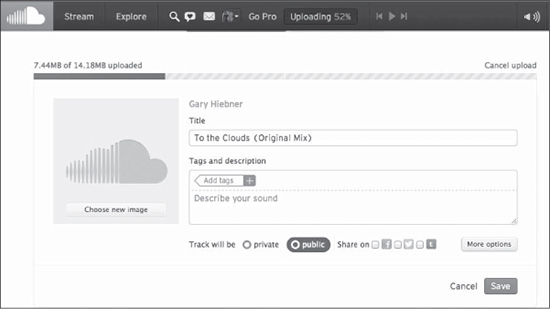
Source: SoundCloud®.
You can also add an image for the track. Maybe this song is from a particular album of yours; if so, you can add the album artwork to the song. We’ll cover images and artwork in more detail in Chapter 6, “Adding Artwork and Tags to Your SoundCloud Audio.”
By default, the audio filename will be given as the Title, but you can go in and rename this if you want to change it. Under this, you can add tags and a description for the audio. The more tags you add, the better its searchability will be on SoundCloud, so think carefully about what tags you want to add. Remember, the more the merrier. We’ll also cover tags in more detail in Chapter 6, as well as how you can optimize them for better searchability.
You have the option to keep your track private, so that only you or selected parties can listen to it. Or, you can choose to make it public for everyone to listen to it. Take a look at the “Difference between Private and Public Tracks” sidebar later in this chapter.
You also have options to share it with other social media sites, such as Facebook, Twitter, and Tumblr, as shown in Figure 3.4. Just check the appropriate box to make it available there.
Figure 3.4 Sharing to other social media platforms.

Source: SoundCloud®.
When you’re happy with everything, click on Save to save the changes. If you haven’t yet signed up for any of these other social media platforms, do look into them. Cross-platform integration can be a valuable tool for you as a musician, reaching your fans via their favorite social media channels. For example, sharing to Facebook allows fans that may not visit SoundCloud to still listen to your track through the SoundCloud player. In the past radio, television, and print were the main vehicles for messages around promotion and advertising, but now you have the opportunity to reach your fans with a few clicks of the mouse.
Remember, you can always go in at a later stage to change descriptions, tags, and settings. Navigate to your tracks (choose Tracks from the top menu bar, as shown in Figure 3.5), and then once the track has loaded, click on the Pencil button to edit the data. Or click on the Trash icon if you want to delete a particular track. See Figure 3.6.
Figure 3.5 Navigating to your tracks.
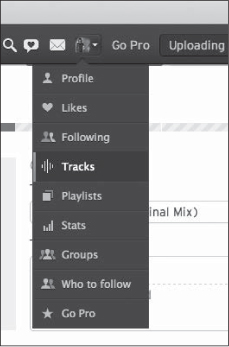
Source: SoundCloud®.
Figure 3.6 Editing or deleting your tracks.

Source: SoundCloud®.
Once the track is uploaded, a waveform representation of the audio file will be shown with the track name. Click on the Play button, and the audio will begin streaming. You can listen through and make sure the track uploaded correctly.
Difference between Private and Public Tracks: When you upload your track, you have a choice to make it either public or private. If you choose to make it public, then anyone can listen to your track.
But let’s say you only want a select few to be able to listen to a particular track. This is where the Private option becomes useful. When you select Private, you can add people to the private track or you can send out a secret link for users to listen to the private track. Scenarios where this would be useful could include collaborations with other musicians or review opportunities where you’re still at a work-in-progress stage and not ready to release the track publically.
To add people, click on Add/Remove People, as shown in Figure 3.7. You can add their SoundCloud user name or add an email address under the Email tab. With the Lists tab, you can share to several people. And the Following and Followers tab will share to your selected followers, or you can choose to send to users you are following.
Figure 3.7 Sharing your tracks with others.

Source: SoundCloud®.
The secret link is very handy. On your private track, click on Share. At the bottom is a secret-link URL address, as shown in Figure 3.8. Copy this address and send it to the people with whom you want to share the track. Recipients of the link will be able to navigate to this track and listen to it or download it to review.
Figure 3.8 Using a secret link with your private tracks.
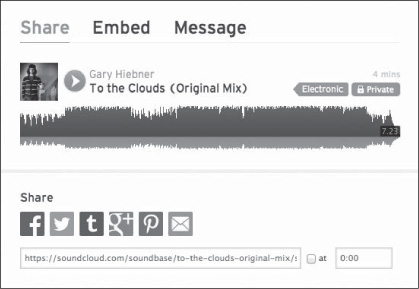
Source: SoundCloud®.
SoundCloud and Supported Audio Formats
What puts SoundCloud above most of the other social media tools for musicians is that it supports a comprehensive list of audio formats. This means that you can print/render/export your songs at high-quality formats from your audio software so that your listeners can hear top-quality recordings. It supports all the most commonly used compressed and uncompressed audio formats.
Here are the audio formats supported:
![]() AIFF
AIFF
![]() WAV
WAV
![]() FLAC
FLAC
![]() ALAC
ALAC
![]() OGG
OGG
![]() MP2
MP2
![]() MP3
MP3
![]() AAC
AAC
![]() AMR
AMR
![]() WMA
WMA
That is quite an extensive list! The beauty of this is that you don’t need to compromise your audio quality when you upload to SoundCloud. You can upload an uncompressed high-quality WAV version of your track. And if you want to use an MP3 because the file size is smaller, you can still use a high bit rate, such as 320kbps.
You’re probably wondering what I mean by uncompressed and compressed audio. It can also be called lossless and lossy audio compression. Compressed audio is usually compressed to reduce the file size. In the process, the audio quality is degraded. Often the results are barely noticeable to the average listener, but audio specialists will notice the quality difference in the compressed audio formats. AIFF, ALAC, WAV, FLAC, and WMA are uncompressed, lossless audio formats. OGG, MP2, MP3, AAC, and AMR are compressed, lossy audio formats.
So if you want your listeners to hear your audio at its optimum quality, then use the uncompressed, lossless audio formats. But remember that the file size will be much bigger. So the upload process will take slightly longer depending on your Internet upload speeds, but at least, thanks to SoundCloud, you have this option of presenting your audio at its highest quality.
In the next chapter, we’ll take a look at why SoundCloud’s waveform audio display is so unique and valuable to you as a musician and an artist.
